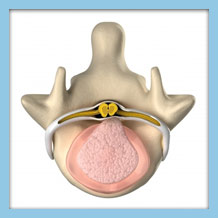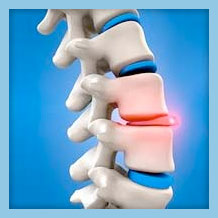

At Orthopedic & Laser Spine Surgery (OLSS), we understand how debilitating back pain can be. Our team of orthopedic surgeons are committed to providing effective, patient-focused care using minimally invasive techniques designed to ease pain, improve mobility, and restore your quality of life. Whether your back pain stems from a recent injury or a chronic condition, OLSS offers cutting-edge solutions to meet your needs.
What Causes Back Pain?
Back pain often arises from a combination of factors, including lifestyle, physical stress, and underlying medical conditions. While some cases are linked to obvious causes like injury, others may stem from gradual wear and tear or structural problems within the spine.
Muscular Injuries
Muscle strains and ligament sprains are among the most common causes of back pain. These injuries can result from overuse, heavy lifting, or sudden movements that overstretch the soft tissues of the back. Poor posture during repetitive tasks or prolonged sitting can also lead to muscle tension and back discomfort. For example, slouching while working at a desk may gradually strain the lower back muscles, causing pain to develop over time.
Spinal Degeneration
Age-related changes in the spine are a leading contributor to back pain. Conditions like degenerative disc disease and osteoarthritis occur as the cartilage cushioning the spinal joints wears away. This degeneration can cause the spinal bones to rub against each other, resulting in stiffness, pain, and reduced mobility. People with spinal degeneration often feel pain worse after periods of inactivity or prolonged sitting.
Herniated or Bulging Discs
Discs act as shock absorbers between the vertebrae in the spine. When a disc becomes damaged or begins to bulge, it can press against nearby nerves, causing shooting pain, numbness, or tingling sensations. Herniated discs often lead to leg pain, as the pressure on the sciatic nerve may radiate down the lower limbs. This type of back pain may start suddenly, often after a specific movement or heavy lifting.
Spinal Stenosis
Spinal stenosis is a condition where the spinal canal narrows, compressing the spinal cord and surrounding nerves. This can result in back pain, leg pain, and difficulty walking or standing for extended periods. People with spinal stenosis may also experience relief when sitting or leaning forward, as this position reduces pressure on the spinal nerves.
Traumatic Injuries
Falls, car accidents, or sports-related injuries can cause fractures or dislocations in the spine, leading to acute back pain. Even minor injuries can aggravate pre-existing conditions, turning occasional discomfort into persistent pain. Trauma often requires immediate medical attention to assess the extent of damage and prevent further complications.
Uncommon Causes
In rare cases, back pain may result from infections, tumors, or other systemic medical conditions. For example, spinal infections can cause localized inflammation, while tumors may press against nerves or the spinal cord, leading to sharp pain. Identifying these uncommon causes often requires thorough diagnostic evaluation.
Diagnosing Back Pain
Proper diagnosis is the first step toward effective back pain treatment. Because back pain can stem from a variety of underlying causes, a thorough evaluation is essential to identify the specific issue contributing to your discomfort.
Physical Examination
A healthcare provider will start by assessing your symptoms and conducting a physical examination. This includes checking your range of motion, testing reflexes, and evaluating muscle strength. The provider may ask you to perform simple movements to pinpoint areas of pain and identify potential mechanical or structural problems.
Imaging Techniques
Advanced imaging tools play a critical role in diagnosing back pain. X-rays can reveal fractures, bone spurs, or alignment issues in the spinal column, while magnetic resonance imaging (MRI) provides detailed images of soft tissues like muscles, discs, and nerves. These imaging studies help uncover conditions like herniated discs, spinal stenosis, or degenerative changes that may not be visible through a physical exam alone.
Specialized Testing
In some cases, nerve studies or electromyography (EMG) tests may be used to assess nerve function. These tests measure electrical activity in the muscles and nerves, helping to identify any damage or compression. Diagnostic tools like these ensure an accurate understanding of your condition, allowing for a targeted treatment plan.
At OLSS, we utilize the latest diagnostic technologies to uncover the root cause of your back pain. By combining thorough evaluations with advanced imaging and testing, we provide you with a clear diagnosis and a roadmap for pain relief. Let us help you take the first step toward recovery.
What Does My Back Pain Mean?
Back pain can range from mild discomfort to severe pain that disrupts your daily life. However, it’s important to recognize when your symptoms may indicate a more serious underlying cause. Certain warning signs should prompt immediate medical attention, such as sudden loss of bladder or bowel control, significant weakness in the legs, or sharp pain that radiates down one or both legs. These symptoms may signal nerve compression or a serious spinal condition requiring prompt intervention.
Past injuries or trauma can also play a significant role in exacerbating back pain. Even if the initial injury seems minor, untreated damage can lead to chronic conditions over time. For example, a fall or sports-related injury may cause subtle structural problems in the spine that worsen with age or additional strain. Understanding your medical history and how previous injuries might contribute to your pain is essential for an accurate diagnosis and effective treatment plan.
At Orthopedic & Laser Spine Surgery, we’re committed to helping you find the right solution for your back pain. Using our Treatment Match Tool, you can provide key information about your symptoms, helping our specialists identify potential causes and recommend the best course of action. Start your journey toward recovery today with our easy-to-use online tool.
Non-Surgical Back Pain Treatments
In many cases, back pain can be managed effectively with non-surgical treatments. These conservative approaches are designed to relieve discomfort, reduce inflammation, and restore mobility, often without the need for invasive procedures.
Physical Therapy
Physical therapy is a cornerstone of back pain management. A trained therapist can guide you through exercises tailored to strengthen the muscles supporting your spine, improve flexibility, and correct posture. These exercises can ease pain caused by muscle tension or mechanical problems, reducing the likelihood of recurrence. Additionally, physical therapy promotes better blood flow to the affected area, accelerating the healing process.
Medications
Anti-inflammatory medications, such as nonsteroidal anti-inflammatory drugs (NSAIDs), are often recommended to reduce swelling and alleviate pain. For more intense discomfort, muscle relaxants may be prescribed to relieve spasms or tightness in the back. These medications can provide significant relief for acute back pain, allowing patients to resume daily activities more comfortably.
Injection-Based Therapies
For patients with persistent or severe pain, injection therapies may offer targeted relief. Corticosteroid injections can reduce inflammation around irritated nerves, while nerve block injections can temporarily interrupt pain signals to the brain. These treatments are particularly beneficial for conditions like spinal stenosis or herniated discs, where inflammation plays a key role in pain development.
Benefits of Non-Invasive Approaches
Starting with non-surgical treatments offers several advantages. These methods are generally less risky than surgery, involve minimal downtime, and often provide substantial relief when used consistently. At OLSS, our specialists prioritize these conservative approaches whenever possible, helping you return to your normal routine without unnecessary interventions.
Minimally Invasive Surgical Solutions
When conservative treatments don’t provide adequate relief, minimally invasive surgery may be the next step. Orthopedic & Laser Spine Surgery specializes in advanced surgical techniques that address the root causes of back pain while minimizing recovery time and complications.
Minimally Invasive Spine Surgery (MISS)
MISS is a cutting-edge approach to spinal surgery that uses small incisions and specialized instruments to access and treat the affected area. Unlike traditional open surgery, MISS involves minimal disruption to surrounding muscles and soft tissues, leading to faster recovery times and reduced postoperative pain. This technique is effective for treating conditions such as herniated discs, spinal stenosis, and degenerative disc disease.
Artificial Disc Replacement
For patients with severe disc degeneration, artificial disc replacement offers an innovative solution. At OLSS, we use the M6 artificial disc, which mimics the natural movement of a healthy disc, allowing for greater flexibility and range of motion compared to traditional spinal fusion. This advanced technology helps restore functionality and alleviate pain caused by worn or damaged discs.
Endoscopic Procedures
Endoscopic spinal surgery is another minimally invasive option for addressing specific conditions like disc herniation or pinched nerves. This technique involves inserting a small camera and surgical tools through a tiny incision, allowing surgeons to precisely target the problem area. Patients benefit from reduced scarring, minimal blood loss, and quicker recovery compared to conventional surgery.
Benefits of Minimally Invasive Surgery
Minimally invasive surgical solutions provide several key advantages:
- Shorter Recovery Periods: Most patients can return to normal activities within weeks rather than months.
- Minimal Scarring: Small incisions lead to less visible scarring and a more aesthetic outcome.
- Less Pain and Faster Healing: By preserving healthy soft tissues, these procedures significantly reduce postoperative discomfort and complications.
At OLSS, our expert orthopedic surgeons combine technical precision with compassionate care to deliver exceptional results. If you’re considering surgery, trust us to provide the most advanced and minimally invasive options tailored to your needs.
FAQs About Back Pain Treatments
What causes back pain to worsen over time?
Back pain can worsen due to several factors, including untreated injuries, poor posture, and mechanical or structural problems within the spine. Degenerative conditions, such as osteoarthritis or degenerative disc disease, may also lead to progressively worsening symptoms. Addressing the underlying cause early can prevent further complications and improve long-term outcomes.
When should I see a healthcare provider for back pain?
You should consult a healthcare provider if your back pain persists for more than a few weeks, interferes with daily activities, or is accompanied by symptoms like shooting pain, numbness, or loss of bladder or bowel control. These could indicate a serious spinal condition that requires immediate attention.
What are the benefits of minimally invasive surgery?
Minimally invasive procedures, such as those offered by OLSS, provide significant benefits, including shorter recovery periods, minimal scarring, reduced risk of complications, and less postoperative pain. These techniques are ideal for conditions like herniated discs or spinal stenosis, offering targeted relief while preserving healthy tissue.
How long does it take to recover from back pain treatments?
Recovery times vary depending on the treatment method. Non-surgical treatments, such as physical therapy or injections, may show results within weeks, while recovery from minimally invasive surgery typically takes a few weeks to a few months, depending on the individual.
Does insurance cover back pain treatments?
Most insurance plans cover medically necessary procedures for back pain, including diagnostic tests, physical therapy, and surgery. Our team at OLSS can help you navigate your insurance coverage and ensure you receive the care you need without unnecessary financial stress.
Ready to Begin Your Journey to Back Pain Relief?
Back pain doesn’t have to define your life. At Orthopedic & Laser Spine Surgery, all of our Florida spine centers provide a comprehensive approach to diagnosis and treatment, tailored to each patient’s unique needs. Our advanced diagnostic tools and minimally invasive surgical solutions allow us to deliver precise, effective care that helps you return to a pain-free lifestyle.
Whether you’re dealing with acute back pain, a herniated disc, or a more complex condition like spinal stenosis, our highly trained team is here to guide you every step of the way. With decades of experience and a focus on patient-centered care, we’re committed to helping you achieve lasting relief and improved mobility.
Take the first step today by using our easy-to-navigate Treatment Match Tool, or contact us directly to schedule an appointment. Your path to recovery starts here.
If you have any additional questions or concerns, don’t hesitate to reach out. Together, we’ll work toward a solution that restores your health and quality of life.
